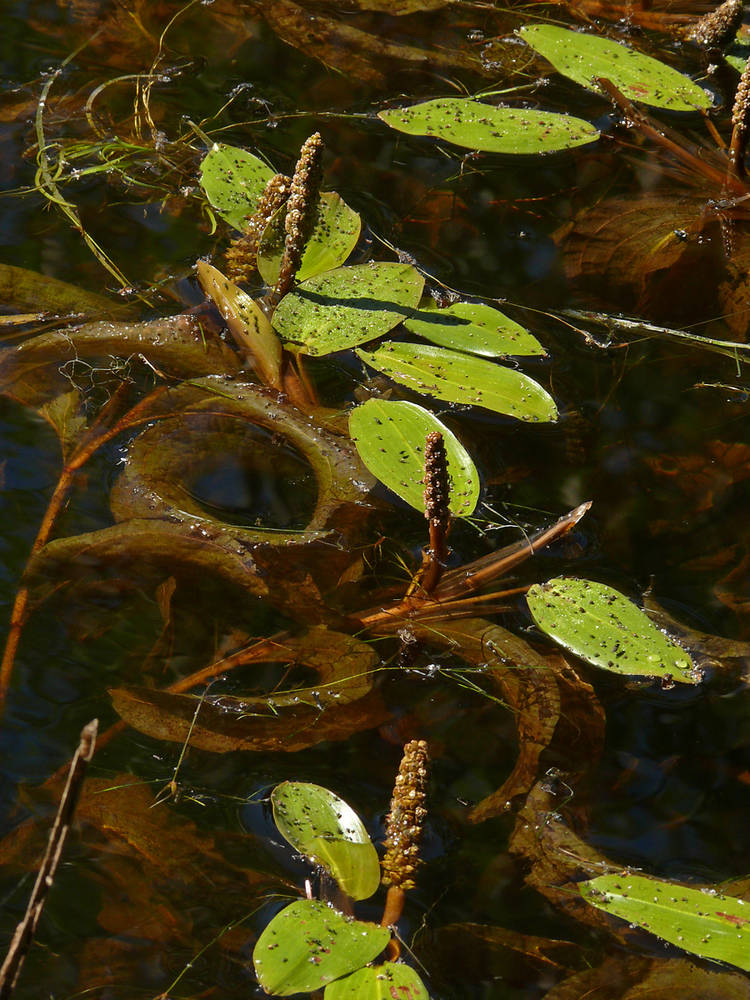
Stems terete, 6–110 cm; nodal glands absent.
Leaves submersed and floating or rarely submersed only.
Submersed leaves petiolate, attached to stem nodes, not attached to stipules; stipules 15–117 mm, tip acute; blades ovate to oblanceolate, distinctly falcate, 50–125 × 15– 58 mm; base rounded to acute; margins entire and recurved, wavy; tip acute to round-apiculate; veins 19–49; petioles terete, 0.9–11.5 cm.
Floating leaves lanceolate to round elliptic, 43–92 × 25–38 mm, light green; base rounded to cordate; tip acute to rounded; veins 27–49; petioles 23–226 mm.
Inflorescences emersed; spikes cylindric, 34–65 mm; peduncles terminal or axillary, erect, cylindric, 45–223 mm.
Fruits sessile, obovoid, turgid, 5–6.7 × 4.5–5.2 mm, reddish brown, dorsally keeled, laterally ridged; beaks erect, 0.5–0.8 mm.
Lakes, ponds, streams. 0–2100m. BR, BW, Casc, CR, ECas, Est, WV. CA, ID, WA; north to British Columbia, east to Newfoundland. Native.
Potamogeton amplifolius has large submersed leaves that are folded and falcate and have numerous veins. This species hybridizes with P. illinoensis.
as described under Potamogeton amplifolius
Rhizomes present. Cauline stems terete, often rusty spotted, 6--110 cm; nodal glands absent. Turions absent. Leaves both submersed and floating or floating absent, ± spirally arranged. Submersed leaves petiolate, lax; stipules persistent, conspicuous, convolute, free from blade, light brown, not ligulate, 1.5--11.7 cm, not fibrous, not shredding at tip, apex acute; petioles terete, 0.9--11.5 cm; blade light to dark green, ovate to oblanceolate, distinctly arcuate, 5--12.5 cm ´ 15--58 mm, base rounded to acute, without basal lobes, not clasping, margins entire, crispate, apex not hoodlike, acute to round-apiculate, lacunae absent; veins 19--49. Floating leaves: petioles continuous in color to apex, 2.3--22.6 cm; blade adaxially light green, lanceolate to round elliptic, 4.3--9.2 cm ´ 25--38 mcm, base rounded to cordate, apex acute to rounded; veins 27--49. Inflorescences unbranched, emersed; peduncles not dimorphic, terminal or axillary, erect, cylindric, 4.5--22.3 cm; spikes not dimorphic, cylindric, 34--65 mm. Fruits sessile, reddish brown, obovoid, turgid, abaxially keeled, laterally ridged, 5--6.7 ´ 4.5--5.2 mm, lateral ridges without points; beak erect, 0.5--0.8 mm; sides without basal tubercles; embryo with full spiral. 2n = 52.Flowering summer--fall. Waters of lakes, ponds, streams, and rivers; 0--1900(--2900) m; B.C., Man., N.B., Nfld. and Labr. (Nfld.), N.S., Ont., Que., Sask.; Ala., Ark., Calif., Conn., Ga., Idaho, Ill., Ind., Iowa, Kans., Maine, Md., Mass., Mich., Minn., Mo., Mont., Nebr., N.H., N.J., N.Y., N.C., Ohio, Okla., Oreg., Pa., R.I., S.Dak., Tenn., Vt., Va., Wash., W.Va., Wis., Wyo.No specimens have been seen from Kentucky or Texas, but the species is to be expected there.Potamogeton amplifolius is common throughout much of North America. Its submersed leaves are larger than those of most other species of Potamogeton, are arcuate, and have more veins than do any other species.One hybrid, Potamogeton amplifolius ´ P. illinoensis (= P. ´ scoliophyllus Hagström), has been described.